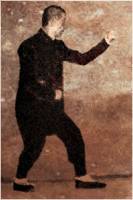Xingyiquan is a very old Chinese martial art that most believe originated in the early 1600s. It is a very powerful art which is classified as an internal system like it's sister arts Taijiquan (Tai Chi) and Baguaquan. However, Xingyi's mindset is that of an aggressive nature. Where Taijiquan yields and blends with an opponent's attack, and Bagua circles and evades, Xingyi smashes right through the opponent in a linear fashion with an unrelenting attack.
Xingyiquan is a no-nonsense fighting system - relatively easy to learn, but difficult and long to master. Proper body mechanics and quieting of the mind and body are of utmost importance to excel in this art. The power is generated from the ground in the Xingyi practitioner's legs, funneled up through the body and out the arms. In fact, when the practitioner strikes, he is striking with his entire body, not just his fists.
The heart of Xingyi are the five fist forms or "wu xing." These are short repetitive forms each depicted by the Chinese five elements of metal, wood, water, fire and earth. Each one generates a different kind of energy or fighting power and each one corresponds to an internal organ of the body. Advanced training introduces twelve animal forms based on the five fists.
Xingyi boxers move linearally, stepping forward or angling in and out on straight lines. The basic posture is
"San Ti Shi", which is used as a standing excercise as well. The feet, the head and the lead hand are usually held on the same vertical plane, so the practitioner moves directly into the opponent, in contrast to many other fighting styles that often have circular motions, sidestepping patterns, and body shifting.
A Xingyi boxer rarely puts his weight on the front foot and almost never assumes a posture where the weight is evenly distributed. When he does move, it is from one leg to another, much as a chicken moves when running.
The linear stepping techniques naturally reveals Xingyi's strategy - offense. Unlike the passive approach stereotyped with internal arts, the Xingyi boxer will take the offense immediately and not let up until the enemy is down.
To achieve such ferocity, a Xingyi boxer will train in forcing the opponent back (and under the stress of the moment, people do tend to move straight back as a reflex to escape). Once the opponent back steps and provides space, the boxer will press into the space while delivering another powerful attack with coordinated body movements attacking from the centerline.
Xingyi stylists practice few movements with high numbers of repetition. Compared to the forms of many northern styles, Xingyi's forms are comparatively short, some having only one movement. The essence of Xingyi consists of five fist movements, known as five elemental boxing, and practioners practice the five moves relentlessly, realizing that in a fight these are the ones they will use.
A Xingyi boxer learns that every movement in the art has a purpose for consuming the opponent. Perhaps that is the reason why in a small region, among the Yellow River's plains and valleys, the art earned the reputation as a no-nonsense approach to fighting.










